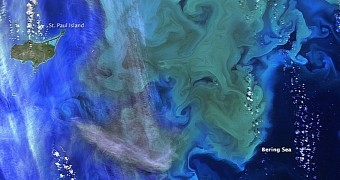Towards the end of last week, on January 9, NASA scientists released a stunning image showing a phytoplankton bloom off the coast of Alaska. The image was obtained several months ago with the help of the Landsat 8 satellite.
As one can easily notice, this NASA image showing the waters close to Alaska's Pribilof Islands in the Bering Sea is green and blue all over. These two colors indicate the presence of teeny tiny organisms collectively known as phytoplankton.
Researchers say that such blooms are a fairly common sight in the Bering Sea, especially during spring. This is because this is when, following the retreat of the winter ice cover, the water near the surface is not only fresh but also rich in all sorts of nutrients.
Come summer, the blooms disappear. This happens because, eventually, the microorganisms that form them gobble up all the nutrients that made it possible for them to thrive just weeks before. When autumn storms bring a fresh batch of nutrients to the region, new blooms appear.
It is understood that NASA's Landsat 8 satellite obtained this image, dating back to September 22, 2014, using its Operational Land Imager. The Imager, built by the Ball Aerospace & Technologies Corporation, can snap pictures in visible, infrared and short-wave light.

 14 DAY TRIAL //
14 DAY TRIAL //